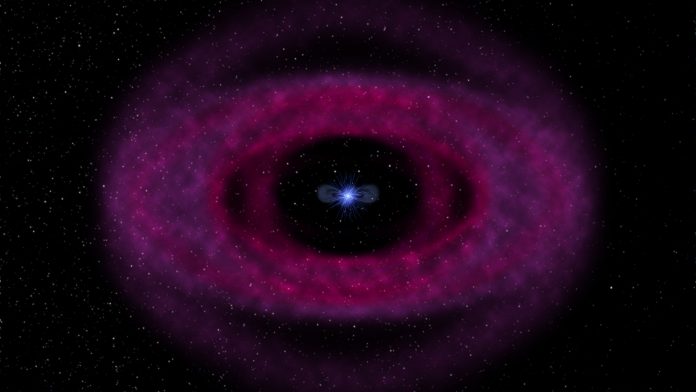A team of astronomers at Warwick University have observed a record-breaking spin rate for a confirmed white dwarf star.
Researchers have recorded a white dwarf star completing a full rotation once every 25 seconds, thus making it the fastest spinning confirmed white dwarf according to a team of Warwick University lead astronomers.
The team have observed the spin period of the star for the first time, stating that it is as an extremely rare example of a magnetic propeller system. The white dwarf is pulling gaseous plasma from a nearby companion star and hurling it into space at around 3000 kilometres per second.
Reported in the journal, Monthly Notices of the Royal Astronomical Society: Letters, it is the second magnetic propeller white dwarf to have been identified in over 70 years, due to a combination of powerful and sensitive instruments that allowed scientists to catch a glimpse of the speeding star.
This study was led by the University of Warwick and the University of Sheffield, funded by the Science and Technology Facilities Council (STFC) as part of UK Research and Innovation, and the Leverhulme Trust.
White dwarf star spin speed
A star that has burnt up all of its fuel and shed its outer layers, now undergoing a process of shrinking and cooling over millions of years is labelled a white dwarf star. The star that the Warwick research team has observed has been named LAMOST J024048.51+195226.9 – or J0240+1952 for short.
It is the size of the Earth but is thought to be at least 200,000 times more enormous. It is part of a binary star system, and its immense gravity is pulling material from its larger companion star in the form of plasma. This plasma was, in the past, falling onto the white dwarf’s equator at a high speed, providing the energy that has given it this high-speed spin. For instance, one rotation of the planet Earth takes 24 hours, while the equivalent on J0240+1952 is a mere 25 seconds, which is nearly 20% faster than the confirmed white dwarf with the most comparable spin rate, which completes a rotation in just over 29 seconds.
Nevertheless, at some point in its evolutionary history J0240+1952 developed a strong magnetic field. The magnetic field acts a protective barrier, resulting in most of the falling plasma to be propelled away from the white dwarf. The remainder will flow towards the star’s magnetic poles. It gathers in bright spots on the surface of the star and as these rotate in and out of view, causing pulsations in the light that the astronomers observe from Earth. They then used this to measure the entire stars rotation.
“J0240+1952 will have completed several rotations in the short amount of time that people take to read about it, it is really incredible,” said lead author Dr Ingrid Pelisoli of the University of Warwick Department of Physics. “The rotation is so fast that the white dwarf must have an above average mass just to stay together and not be torn apart. It is pulling material from its companion star due to its gravitational effect, but as that gets closer to the white dwarf the magnetic field starts to dominate. This type of gas is highly conducting and picks up a lot of speed from this process, which propels it away from the star and out into space.”
Magnetic propeller systems
J0240+1952 is one of only two stars with this magnetic propeller system discovered in over the past 70 years. Although material being hurled out of the star was first observed in 2020, astronomers had been unable to confirm the presence of a rapid spin that is a main ingredient of a magnetic propeller. This is due to the pulsations being too fast and dim for other telescopes to observe.
To visualise the star at that speed for the first time, the University of Warwick research team used the highly sensitive HiPERCAM instrument, jointly operated by Warwick and the University of Sheffield with funding from the European Research Council. This was specially mounted on the largest functioning optical telescope in the world, the 10-metre diameter Gran Telescopio Canarias in La Palma, in order to capture as much light as possible.
“These kinds of studies are possible thanks to the unique combination of the fast-imaging capability of HiPERCAM with the largest collecting area in the world provided by GTC,” explained Antonio Cabrera, Head of GTC Science Operations.
Co-author Professor Tom Marsh from the University of Warwick Department of Physics added, “it’s only the second time that we have found one of these magnetic propeller systems, so we now know it’s not a unique occurrence. It establishes that the magnetic propeller mechanism is a generic property that operates in these binaries if the circumstances are right. The second discovery is almost as important as the first as you develop a model for the first and with the second you can test it to see if that model works. This latest discovery has shown that the model works really well, it predicted that the star had to be spinning fast, and indeed it does.”









